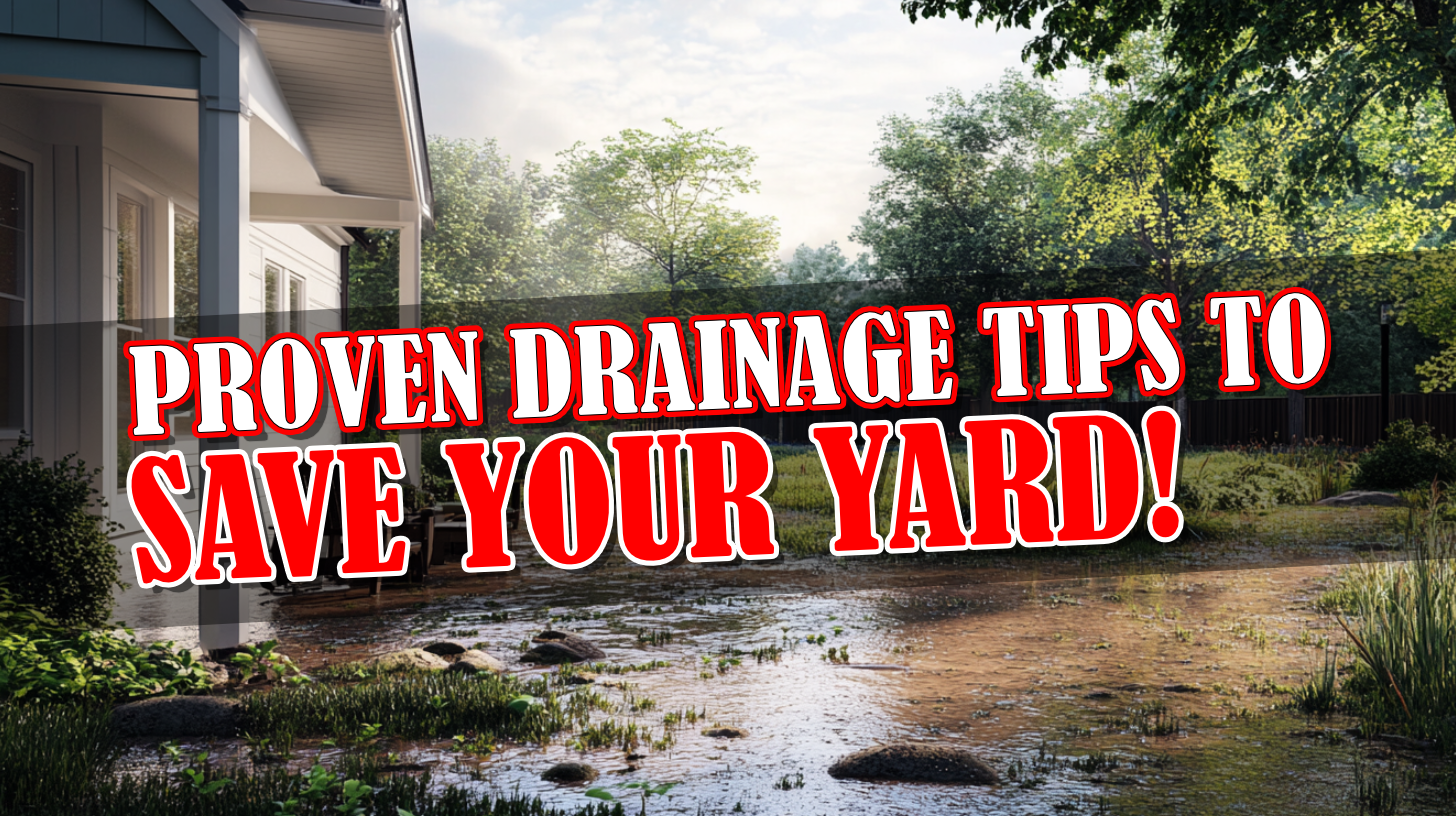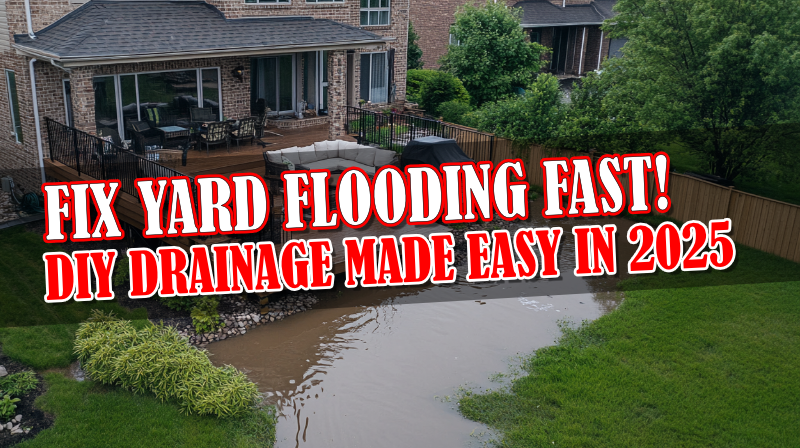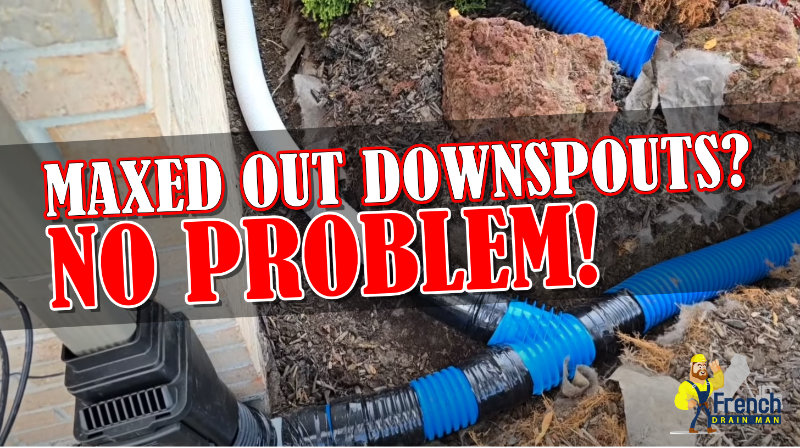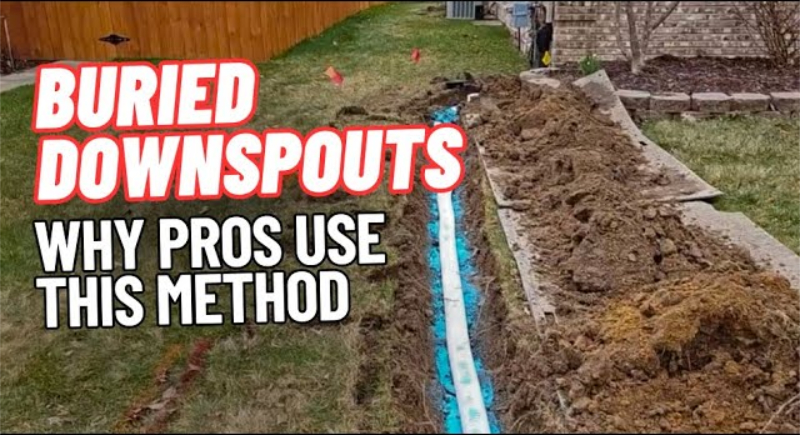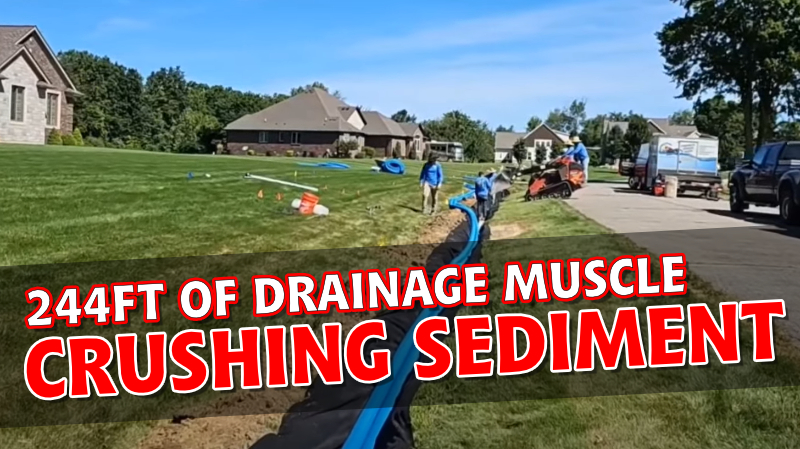
In this video, we look at a French drain installation project in Bruce Township, Michigan, where the primary challenge was minimizing sediment infiltration in an environment with high sediment accumulation. Sediment is one of the greatest threats to French drains; it can clog pipes, reduce water flow, and significantly diminish their effectiveness. When building near wet ditch bottoms, where sediment often gathers and settles quickly, extra precaution must be taken to ensure long-term effectiveness and longevity for this drainage system.
This project required an unconventional strategy to combat its heavy sediment load. Traditional French drain installations may not withstand such conditions, so strategic trench slopes, specialty materials, and multi-layer sediment filtration methods were essential. The team constructed an efficient French drain that filters out sediment and provides decades of reliable service by employing double-punched geotextile fabric, carefully chosen stones, and an advanced pipe system.
This project overview shares specific techniques for managing sediment and protecting drain systems in high-sediment environments. Whether you are a homeowner, contractor, or DIY enthusiast, this article can give invaluable insights into how you can implement similar strategies to maintain functional French drains even under challenging circumstances.
The Sediment Problem in Ditch Bottoms
Ditch bottoms pose unique drainage management challenges, with sediment buildup being one of the primary issues. Ditches are natural low points in the landscape where water gathers and deposits soil, debris, and other material from its surroundings into them—eventually collecting at the bottom of a ditch as a thick layer that reduces its performance as a drainage system. French drain systems, which rely on free-flowing through pipes and stone beds without obstruction from blockages due to sediment buildup, in particular, reduce effectiveness.
The Bruce Township project had a unique challenge in that its ditch bottom consistently remained wet, creating an ideal breeding ground for sediment accumulation. Every time it rained or water entered the ditch; more sediment would enter, fueling an endless cycle whereby sediment continued to accumulate despite attempts at removal. If left unchecked, this sediment could have filled French drain pipes and stone cavities between stones, potentially clogging up their drainage systems altogether – this made designing an efficient drainage solution capable of filtering out sediment while still permitting water passage essential to their success.
One of the primary issues associated with sediment accumulation in ditch bottoms is that it disrupts both drainage systems and causes standing water to pool for extended periods. Stagnant water provides breeding grounds for mosquitoes and produces foul odors as organic material breaks down, not to mention other complications like soil erosion that only add further sediment into an already overburdened system. At the Bruce Township project site, homeowners had experienced prolonged standing water that had killed the grass and rendered parts of their yard inaccessible due to standing water for some time – an issue that led them to deal with extensive standing water problems for some time that left their yard utterly inaccessible due to standing water pooling for some time, resulting in standing water erosion issues caused by standing water being added onto to add its sediment load into an already overloaded system amidst already overgrown sediment load in their ditch bottoms causing additional sediment loading issues further compounding sediment load issues in their ditch.
Throughout the Bruce Township project, homeowners had experienced longstanding water issues that left their grass dying off, leaving parts of their yard unusable due to standing water accumulating on the lawn surface, which led to extensive flooding issues caused by soil erosion, which further contributed exacerbated sediment loading from standing water leaving their yard unusable due to further contributing adding sediment load on to that already present when drainage had started on another occasion which a problem already. Unfortunately, soil erosion issues are created in their yard due to standing water sitting. Unfortunately, homeowners had dealt with extended standing water issues, rendering parts unusable due to problems due to standing water pools being left unusable due to becoming unusable and reducing usability. The Bruce Township project also caused grass to be killed as well. This resulted in unusability accumulated around their yard due to standing water left from getting to sitting, rendering parts unusable as part. This caused the grass to die off due to standing water accumulating longer than expected, leading to long-term standing water issues and killing off.
To address this problem, French drain systems were essential for handling water drainage and managing sediment influx. Without sufficient sediment management systems, drains would experience frequent maintenance needs or require complete replacement within a few years. Still, by addressing their sediment problem up-front with carefully designed systems, homeowners could expect their drains to work for decades instead of needing frequent maintenance or replacement costs.
Ditch bottom sediment issues present a formidable challenge that calls for expert solutions. Gaining insight into how sediment accumulates and impacts drainage systems reveals why a robust multi-layered approach must be adopted for long-term effectiveness. Bruce Township project’s French drain design highlights this imperative; by not only carrying away water but also keeping sediment away from clogging the system and creating smooth drainage while protecting the landscape from potential adverse effects associated with standing water, French drains were designed that not only handle it all while simultaneously protecting it all from standing water accumulation.
Achieving the Correct Slope for Optimal Drainage
Designing a French drain system with the appropriate slope is one of the key elements to its successful development. Ensuring water flows freely throughout the system and reduces stagnation and sediment buildup is of the utmost importance to prevent stagnation and sediment buildup—two problems associated with wet environments where sediment accumulation is likely. A properly sloped trench ensures water moves efficiently through it without the risk of blockages, which would shorten its lifespan.
French drains usually require a slope of approximately one percent (1 in/10 feet of trench). This gentle gradient helps water flow freely without pooling in any spot, preventing sediment from settling within pipes or stone beds. On this project, the crew created an even, consistent gradient that would pull water away from the ditch bottom and direct it toward the storm drain for the efficient performance of the French drain. Continuous movement through this trench system reduced sediment buildup significantly, leading to greater overall efficiency of French drain systems.
The team decided to drop the trench by 6 inches near the storm drain to maintain a consistent slope. This steep drop at the discharge point is essential when dealing with high sediment environments; without it, the risks of leaving behind sediment or standing water could compromise drainage systems and lead to clogs over time. By adding this sharp drop near the discharge point, a stronger gravitational pull ensures both water and any carried sediment fully drain out of the trench system.
Proper slope management is especially essential in areas prone to high sediment accumulation. At Bruce Township ditch, where sediment flows with runoff water, even minor adjustments could cause water flow to stagnate, leading to sediment settling in pipes and potentially clogging the system. By measuring and maintaining an appropriate slope throughout the trench, the crew ensured water was flowing steadily, flushing out sediment without risk of system failure; this approach not only maximizes the performance of the French drain but also extends its life expectancy.
Implementation is crucial when working in challenging environments like Bruce Township. Without the correct slope, even top materials and construction techniques could fall short, leading to constant repairs and maintenance needs for a drainage system. Creating an even and calculated gradient slope for their French drain system in Bruce Township will guarantee long-term success – protecting properties against standing water accumulation and excess sediment buildup for many years.
Layering Stone for Sediment Control
As part of any French drain system, stone is essential in managing sediment and maintaining drainage system efficiency. Stone provides a barrier between soil and pipe, allowing water to pass while trapping sediment that would otherwise enter and clog pipe channels. At the Bruce Township project site, the team took an innovative multi-layered approach to stone placement to optimize sediment control despite high sediment environments in the ditch bottom.
Small pea-sized stones were selected as primary filtering material around drainage pipes for this project in Bruce Township. Small stones create tighter “filter zones,” more effectively trapping sediment particles than larger stones. Placing several inches of stones beneath each drainage pipe provided spaces where sediment could settle before entering the main pipe, ensuring it had somewhere to settle without interrupting water flow—essential in such high-sediment environments as Bruce Township.
One of the key advantages of using small stones in French drain installations is their ability to filter out finer particles while allowing water to pass efficiently. In this project, small stone served as the second line of defense behind non-woven geotextile fabric by filtering out larger sediment particles while providing backup filtration for any smaller ones that managed to slip through; this double filtration method significantly extends drain lifespan by preventing sediment buildup within its pipes.
Additionally, placing stone underneath the pipe helps water flow freely through the system. Without this stone layering technique, sediment could collect directly at the bottom of the pipe, potentially clogging it over time. By creating voids beneath the pipe with this technique, sediment can accumulate without impeding water flow. This layering technique is essential in environments like Bruce Township ditch, where heavy sediment loads are constantly introduced into the system.
Small stones used in this installation serve as filters and supports, helping stabilize the trench. Surrounding pipes with stone to stabilize their overall structure prevents collapse or shifting that could affect system functionality and ensures long-term drainage performance. Finally, layering stone for sediment control guarantees smooth drainage system operation under challenging environmental conditions despite ongoing sediment accumulation.
Layering stone around a drainage pipe is critical in protecting French drain systems against sediment accumulation. Bruce Township’s team used small, tightly packed stones arranged strategically around and under their pipe to form an effective sediment control system that prevented clogs and ensured decades-long drain performance.
Double-punched non-woven Geo-Textile Fabric
Bruce Township’s French drain installation project required double-punched non-woven geo-textile fabric as an essential element to its long-term effectiveness, mainly when operating in environments with heavy sediment accumulation. This specialized fabric filters out sediment before it enters drainage pipes, serving as the first line of defense against sediment accumulation. It provides increased filtration capabilities, allowing water to pass while keeping sediment at bay.
Non-woven geotextile fabric is an increasingly popular choice in drainage systems due to its ability to balance permeability with durability. Unlike woven fabrics, non-woven geotextiles feature more porous structures that allow water to pass freely through. In this project, its double-punched feature enhances its filtering abilities by creating extra perforations that capture sediment particles more effectively. So, even in environments with high sediment loads (where fine particles may be prevalent), water can still flow efficiently into the drainage system without becoming blocked up by debris clogging up pipes!
Fabric placement around French drain systems is of vital importance for their success. At Bruce Township’s installation, the geotextile fabric was wrapped entirely around its stone and pipe system to encase it fully, effectively encasing all sediment sources entering from all directions into the system rather than just from one point; this ensured sediment would be filtered out before reaching pipes where it may cause blockages or clogs; especially beneficial in high sediment environments as complete encapsulation helps minimize bypass of filtration layers.
The main advantage of non-woven geotextile fabric is its durability under harsh environmental conditions. Constructed to resist degradation from prolonged moisture exposure and fluctuating temperatures, its strength guarantees consistent filtration regardless of soil and sediment shifts—something Bruce Township needed due to constant sediment inflow. Therefore, such durability was essential to provide the system with enough longevity without frequent maintenance needs.
Bruce Township project’s success can be attributed to their incorporation of double-punched non-woven geo-textile fabric and other methods for sediment control, such as stone layering and proper trench slope, into one robust drainage solution for handling high sediment environments effectively. Due to its ability to filter out sediment while permitting free water flow, double-punched non-woven geo-textile fabric proved essential in creating an efficient drainage solution that effectively handled their high sediment environment. Utilization of double-punched non-woven geo-textile fabric reinforces the significance of selecting materials in creating long-term functionality and preventing sediment from compromising drain performance by choosing appropriate materials ensuring long-term functionality and functionality compared with conventional French drain systems used elsewhere – it demonstrates just how effective using double punched nonwoven geo-textile fabric would be in challenging environments. At the same time, its ability to filter out particles while still permitting water passage proved essential in creating an effective drainage solution capable of handling its high sediment environment successfully. Utilization demonstrated how vital fabric’s ability to filter out particles while still allowing water to flow freely makes it an essential component in French drain systems capable of handling challenging conditions – showing its importance by its inclusion here! Its inclusion shows its value by prolonging its long-term functionality without compromise caused by sediment compromise.
Geo-textile fabric played an essential filtration role in this French drain system. It provided a vital filtering layer to stop sediment from clogging the pipes and ensure long-term durability for years to come. By surrounding and protecting this drainage system from Bruce Township’s high sediment environment, this fabric ensured it would continue working effectively in years to come.
Installing Two Pipes for Additional Capacity
In high sediment environments, increasing the capacity of a French drain system is vital to effectively managing both the volume and amount of sediment that builds up over time. Bruce Township made an informed decision to install two pipes instead of just one to increase capacity and improve functionality – one 8-slot high octane pipe moved more water while managing sediment effectively, ensuring a longer lifespan and superior performance from their drainage system.
Two pipes help increase overall void space within a drainage system, making them particularly effective at handling sediment-heavy environments like Bruce Township, where heavy sediment accumulation occurs regularly. When installed separately, sediment can quickly clog one pipe, hindering its ability to move water effectively; with two pipes, however, its load is dispersed over a larger surface area, giving more room for flow while giving an increased capacity to capture any potential stones that enter its system – an especially crucial feature when dealing with heavy loads like Bruce Township!
Installing two pipes increases water flow capacity and enhances the system’s resistance to clogging. By creating more voids in surrounding stone and diverting sediment away from directly entering pipes, two pipes improve resistance against clog. By managing sediment, efficiency remains consistent even under challenging conditions; reliable drainage over the long haul is ensured.
Installing two pipes also provides the added redundancy valuable in high sediment areas like Bruce Township – in case one pipe becomes partially blocked over time, its counterpart still works to allow drainage effectively. This redundancy feature makes installing two pipes essential in protecting water flow without requiring continuous maintenance costs or sacrificing water flow.
Finally, two-pipe systems offer greater future flexibility. If sediment load or water volume increases due to environmental changes, having two pipes ensures your system can still function efficiently without costly upgrades. French Drain Man’s use of two pipes shows how a well-designed drainage system can adapt to challenging conditions while offering homeowners a long-term and low-maintenance solution to their drainage woes.
Overall, adding two pipes to the Bruce Township French drain project significantly expanded its capacity and reduced the risk of clogs significantly, making this design choice ensure the system will function effectively even under conditions of heavy sediment buildup.
Grass as a Natural Sediment Filter
At the Bruce Township French Drain installation, grass was utilized as an organic sediment filter to enhance its performance and optimize overall system operation. When growing on top of a French drain, grass acts as a natural barrier against sediment infiltration by filtering out runoff water before entering the drainage system. It acts like an “interceptor,” trapping particles while permitting flow into the French drain.
Grass plays an integral part in capillary action and gravity-driven filtration processes, creating pathways for water to travel along its roots before entering French drains—filtering out sediment before reaching them! As established grass becomes more effective at controlling sediment, particularly in high-flow areas like Bruce Township ditch.
Not only does grass provide natural filtration, it helps stabilize the trench surface and prevent erosion. Where standing water has killed off grass or caused soil displacement, reintroducing grass over French drain systems can hold soil in place while decreasing sediment washed into drainage systems during heavy rain or water flows – protecting pipes and stone beds below from surface-level sediment disruptions that might otherwise disrupt functionality.
Another advantage of using grass as a sediment filter is that it reduces the need for an open French drain system. Open drains are vulnerable to debris entering their system, potentially clogging it and leading to issues. By covering their French drain with grass instead, homeowners in Bruce Township avoided these drawbacks while benefiting from an effective drainage solution with managed water flow. Plus, grass is a natural and low-maintenance way of controlling sediment build-up without additional filtering mechanisms or frequent cleanouts needed for protection.
Grass adds an aesthetic element to any project. By restoring the yard and planting grass on top of drains, the system becomes integrated with its surroundings while remaining functional. Bruce Township demonstrated how using grass as a natural filter improved system efficiency and helped preserve property beauty.
Conclusion Grass provides an effective and natural sediment filter in the Bruce Township French drain system. It traps sediment, stabilizes soil conditions, and promotes water filtration via capillary action—qualities that make it invaluable in high-sediment environments such as Bruce Township. This approach reduces sediment build-up while still upholding property integrity and appearance.
Final Steps: Ensuring Longevity in High-Sediment Areas
The final steps at the Bruce Township French drain project focused on ensuring the system would last decades even under conditions with high sediment accumulation. Sediment management is an integral component of drainage systems, as too much sediment accumulation can clog pipes and reduce their effectiveness over time. Several key elements were implemented during the final installation stages to address this challenge to maximize the system’s longevity.
One critical step was creating a sharp 6-inch drop near the storm drain. This sharp drop was specifically tailored to ensure water and any remaining sediment were drawn out of the trench efficiently and would flow freely. Without such an abrupt slope at the end of their system, there would have been an increased risk of sediment building up at its base, potentially resulting in blockages over time. By creating such an abrupt slope at its conclusion, our crew ensured sediment and water would continue flowing out efficiently without risk of buildup, preserving efficiency for years ahead.
The crew took great care to completely encase the drainage system with double-punched non-woven geotextile fabric, acting as a filter to block sediment accumulation and protecting stone beds and pipes from direct soil exposure, which could potentially increase sediment accumulation rates faster. Encapsulation is an essential technique in high sediment areas as it creates a long-term barrier that extends the lifespan of drainage systems; here, the fabric ensured sediment would be filtered out before reaching stone beds or pipes and allowed the system to continue working at full capacity for extended periods allowing full capacity operation of drainage system operations for extended periods.
The team used small stones to foundation their drainage pipes and the overall drainage system design. Placing these stones under each pipe created voids where sediment could settle without immediately clogging it, giving enough void space for accumulation to still occur without impacting draining efficiency. By planning for sediment accumulation using stone as filler material and creating enough void space within this framework, they built an efficient drainage system that will continue functioning even as sediment slowly fills its voids over time.
Growing grass over the system to add another natural layer of sediment filtration was the final step in this project, providing an extra natural defense against sediment entering. By covering French drains with grass, the crew added an early defense against sediment that helps filter out debris before it could even reach fabric or stone layers. Furthermore, grass roots will penetrate geotextile fabric, further increasing capillary action that draws water into the system while trapping sediment at its surface – an approach especially effective against high sediment areas as it lowers overall sediment input into the system while postponing cleanouts or maintenance requirements by an extended timeframe.
By taking these final steps—creating a sharp slope, encasing the system, using small stones, and planting grass—the Bruce Township project was made to endure for decades with minimal upkeep required. Each level was designed with sediment management in mind to ensure efficient drainage even under challenging high sediment environments. These techniques offer homeowners protection from long-term water management issues.
Conclusion: Protect Your Yard with Expert Drainage Solutions
The Bruce Township French drain installation exemplifies how careful planning and applying appropriate techniques can create long-term drainage solutions even in challenging high sediment environments. Every step was designed to maximize system durability, from layering small stones for effective filtration to using double-punched non-woven geotextile fabric for superior protection. A sharp slope near the storm drain and dual pipes to increase capacity emphasizes the importance of tailoring each installation to its specific environment.
If you are experiencing drainage issues or want to safeguard your yard against water damage, now is the time to act. French Drain Man offers expert installation across Macomb, Oakland, Lapeer, and St. Clair Counties; our custom drainage solutions can perfectly meet your individual requirements. Give us a call at 248-505-3065.
DIY enthusiasts or professional contractors looking for top-quality drainage supplies should visit The French Drain Man Online Store. We carry American-made drainage products like our patented systems designed to deliver long-lasting results.
Visit and subscribe to the French Drain Man YouTube Channel for helpful tutorials, tutorials, and project examples. Whether it be DIY drainage projects at home or contractors seeking professional insight, our videos offer invaluable advice for success!
French Drain Man can help safeguard your property and ensure long-term drainage success; reach out today!





